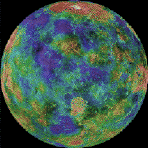
Image: NASA |
Our neighboring planet Venus is an oddball in many ways. For starters, it spins in the opposite direction from most other planets, including Earth, so that on Venus the sun rises in the west. Not that it happens often: a day there lasts a little more than 243 Earth-days, actually making it longer than a Venusian year, which is only about 224 Earth-days long.
Many scientists believe that the long days are a result of the sun's strong pull on the planet. (Mercury, which is even closer to Sol, has fairly long days as well: three for every two Mercury-years). But scientists are still puzzled by Venus's retrograde, or backward, rotation. Now a team of scientists from the French research institute Astronomie et Systemes Dynamiques have proposed a new explanation, published in this week's issue of Nature.
On supporting science journalism
If you're enjoying this article, consider supporting our award-winning journalism by subscribing. By purchasing a subscription you are helping to ensure the future of impactful stories about the discoveries and ideas shaping our world today.
Current theory holds that Venus initially spun in the same direction as most other planets and, in a way, still does: it simply flipped its axis 180 degrees at some point. In other words, it spins in the same direction it always has, just upside down, so that looking at it from other planets makes the spin seem backward. Scientists have argued that the sun's gravitational pull on the planet's very dense atmosphere could have caused strong atmospheric tides. Such tides, combined with friction between Venus's mantle and core, could have caused the flip in the first place.
Now Alexandre Correira and Jacques Laskar suggest that Venus may not have flipped at all. They propose instead that its rotation slowed to a standstill and then reversed direction. Taking into account the factors mentioned above, as well as tidal effects from other planets, the team concluded that Venus's axis could have shifted to a variety of positions throughout the planet's evolution. Regardless of whether it flipped or not, it is bound to settle into one of four stable rotation states¿two in either direction. The researchers add that Venus would be more stable in one of the two retrograde rotational states. So in essence, it was just a question of time before Venus started spinning the wrong way.